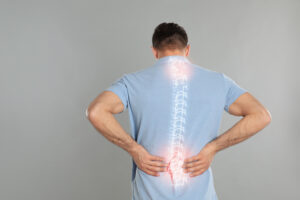
Lumbar Spinal Stenosis Explained
Lumbar spinal stenosis is a condition characterized by the narrowing of the spinal canal in the lower back, which can lead to compression of the spinal cord and nerves. This condition is distinct from other types of stenosis, such as cervical or thoracic stenosis, due to its specific location, symptoms, and treatment options. Understanding the differences between lumbar spinal stenosis and other stenosis issues is crucial for proper diagnosis and treatment. This guide provides detailed information on the unique aspects of lumbar spinal stenosis, its symptoms, diagnostic methods, and treatment options.
Location and Anatomy
Lumbar spinal stenosis specifically affects the lower part of the spine, known as the lumbar region. This region comprises the five vertebrae labeled L1 through L5, which are responsible for supporting much of the body’s weight and allowing for a range of movements. The lumbar spine also contains the cauda equina, a bundle of nerves that supply sensation and muscle control to the legs and bladder.
In contrast, cervical stenosis occurs in the neck region, affecting the vertebrae labeled C1 through C7, while thoracic stenosis affects the mid-back, involving the vertebrae labeled T1 through T12. The anatomical differences in these regions mean that lumbar stenosis primarily impacts the lower body, whereas cervical stenosis affects the neck, arms, and hands, and thoracic stenosis affects the trunk and upper back.
Symptoms
The symptoms of lumbar spinal stenosis are distinct from those of other types of spinal stenosis due to the specific nerves and regions involved. Common symptoms of lumbar spinal stenosis include:
- Lower Back Pain: Persistent or intermittent pain in the lower back.
- Leg Pain and Weakness: Pain that radiates from the lower back into the legs, often described as sciatica. Weakness in the legs may also occur.
- Numbness or Tingling: Sensations of numbness, tingling, or burning in the legs and feet.
- Difficulty Walking: Patients may experience a heavy or tired feeling in the legs, making it difficult to walk or stand for long periods.
- Bladder and Bowel Dysfunction: In severe cases, compression of the cauda equina can lead to loss of bladder or bowel control, a condition known as cauda equina syndrome.
Cervical stenosis, on the other hand, often presents with neck pain, weakness, or numbness in the arms and hands, and thoracic stenosis can cause pain and numbness in the upper back and trunk.
Diagnostic Methods
Diagnosing lumbar spinal stenosis involves a combination of medical history, physical examination, and imaging studies. The following methods are commonly used:
- Medical History and Physical Examination: A healthcare provider will review the patient’s symptoms, medical history, and perform a physical examination to assess nerve function and identify areas of pain.
- Imaging Studies: MRI (Magnetic Resonance Imaging) and CT (Computed Tomography) scans are used to visualize the spinal canal and identify areas of narrowing. X-rays may also be used to assess the alignment and structure of the spine.
- Electromyography (EMG): This test measures the electrical activity of muscles and can help determine if nerve compression is affecting muscle function.
These diagnostic methods help differentiate lumbar spinal stenosis from other types of stenosis and conditions with similar symptoms.
Treatment Options
Treatment options for lumbar spinal stenosis vary depending on the severity of the condition and the patient’s overall health. Common treatments include:
- Management Treatment: Physical therapy, chiropractic adjustments, pain management (including medication and injections), and lifestyle modifications can help alleviate symptoms.
- Surgical Treatments: In cases where management treatments are ineffective, surgical options such as laminectomy (removal of part of the vertebra to relieve pressure) or spinal fusion (joining two or more vertebrae to stabilize the spine) may be considered.
Cervical and thoracic stenosis treatments may involve similar management and surgical options but are tailored to the specific location and symptoms of the stenosis.
The Surgical Alternative: IntraDiscNutrosis®
IntraDiscNutrosis®, a cornerstone treatment at The Nerve & Disc Institute, offers a pioneering alternative specifically designed to treat conditions like lumbar spinal stenosis without surgery. This innovative approach focuses on rejuvenating the spine’s natural healing abilities, particularly beneficial for the lumbar region where stenosis compresses nerve roots and affects lower body function. Unlike traditional surgical interventions that may involve significant risks and recovery times, IntraDiscNutrosis® activates the inherent repair mechanisms within the spinal discs themselves. By addressing both the symptoms and the underlying cause of lumbar spinal stenosis, IntraDiscNutrosis® helps restore function and improve quality of life with minimal downtime and no invasive procedures.
Conclusion
Understanding the unique aspects of lumbar spinal stenosis is essential for accurate diagnosis and effective treatment. Unlike cervical or thoracic stenosis, lumbar spinal stenosis primarily affects the lower back and legs, with specific symptoms and treatment approaches. If you suspect you have lumbar spinal stenosis or are experiencing related symptoms, it is crucial to seek professional medical advice. The Nerve & Disc Institute specializes in diagnosing and treating spinal conditions, offering personalized care to address your specific needs. Contact The Nerve & Disc Institute to schedule a consultation and take the first step towards relief and improved quality of life.